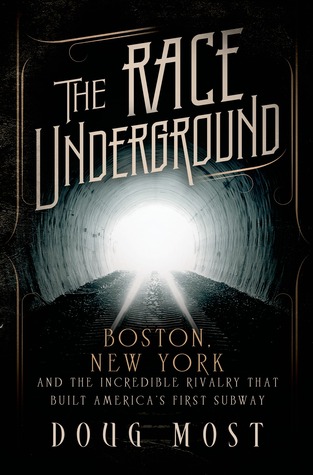This week I'm looking at The Race Underground, by Doug Most, which talks about the history of the construction of the Boston and New York subway systems, at least the initial portions of the subways which have since grown into some of the biggest networks in the world. Most connects these two systems through two brothers, Henry and William Whitney, both of whom were involved in the transportation industry in New York and Boston and were influential in their respective cities in getting the subways built. Although I think Most labors the connection a little too much and it would have been sufficient to talk about the similarities between two large, north eastern cities in the United States who were facing congestion and transportation problems at the end of the nineteenth century.
The biggest problem I had with this book was it felt very disorganized and almost felt like it was trying to be two books instead of one. Most starts out by providing some necessary historical background, such as the development of transportation in American cities, such as horsecar lines and elevated railroads, as well as London's pioneering attempt at constructing a subway with somewhat mixed results and the curious but ultimately unsuccessful attempt to create a pneumatic subway beneath New York. Most then sort of shuttles back and forth between New York and Boston and the individuals, such as the Whitney brothers, who were involved in construction of the subways.
In a way it makes sense to talk about Boston first because Boston completed their subway before New York even got underway, so I can't fault him for that. But I feel like this was almost trying to be two books at once instead of one cohesive book because the Boston narrative is significantly different from the New York narrative and the connection through the Whitneys is tenuous at best. I almost would have preferred that Most had focused on just one of the cities to keep the narrative more focused.
I also wasn't a fan of the inclusion of biographies of almost everyone tied to the projects, including a brief biography of the first motorman to drive a car into the Boston subway. While it may be a humanizing element I've already completely forgotten his name and whatever special things Most said about him in the book. While it's important to talk about things that relate to the narrative, such as the development of electric motors by Frank Sprague, which made electric-powered streetcars and subways a possibility, I don't know if we needed to go into Sprague's entire career including his time at Annapolis and all the challenges involved in getting electric streetcars to actually work. I think Most just suffered from trying to include absolutely everything when he should have kept a tighter focus.
Overall it's really the fact that the book's all over the place that bothers me the most. I'm somewhat familiar with the development of civic transportation, especially within my home city, so some of the information was a repeat to me, but I still found it interesting. I just think Most shouldn't have gone all over the place with his narrative and jump backwards and forwards through time at points.
- Kalpar


No comments:
Post a Comment